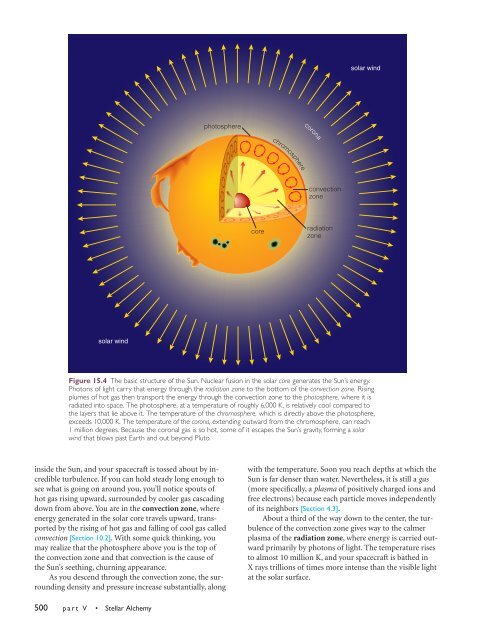Chapter 15--Our Sun - Geological Sciences
Chapter 15--Our Sun - Geological Sciences
Chapter 15--Our Sun - Geological Sciences
You also want an ePaper? Increase the reach of your titles
YUMPU automatically turns print PDFs into web optimized ePapers that Google loves.
solar wind<br />
photosphere<br />
corona<br />
chromosphere<br />
convection<br />
zone<br />
core<br />
radiation<br />
zone<br />
solar wind<br />
Figure <strong>15</strong>.4 The basic structure of the <strong>Sun</strong>. Nuclear fusion in the solar core generates the <strong>Sun</strong>’s energy.<br />
Photons of light carry that energy through the radiation zone to the bottom of the convection zone. Rising<br />
plumes of hot gas then transport the energy through the convection zone to the photosphere, where it is<br />
radiated into space. The photosphere, at a temperature of roughly 6,000 K, is relatively cool compared to<br />
the layers that lie above it. The temperature of the chromosphere, which is directly above the photosphere,<br />
exceeds 10,000 K. The temperature of the corona, extending outward from the chromosphere, can reach<br />
1 million degrees. Because the coronal gas is so hot, some of it escapes the <strong>Sun</strong>’s gravity, forming a solar<br />
wind that blows past Earth and out beyond Pluto.<br />
inside the <strong>Sun</strong>, and your spacecraft is tossed about by incredible<br />
turbulence. If you can hold steady long enough to<br />
see what is going on around you, you’ll notice spouts of<br />
hot gas rising upward, surrounded by cooler gas cascading<br />
down from above. You are in the convection zone,where<br />
energy generated in the solar core travels upward, transported<br />
by the rising of hot gas and falling of cool gas called<br />
convection [Section 10.2].With some quick thinking, you<br />
may realize that the photosphere above you is the top of<br />
the convection zone and that convection is the cause of<br />
the <strong>Sun</strong>’s seething, churning appearance.<br />
As you descend through the convection zone, the surrounding<br />
density and pressure increase substantially, along<br />
with the temperature. Soon you reach depths at which the<br />
<strong>Sun</strong> is far denser than water. Nevertheless, it is still a gas<br />
(more specifically, a plasma of positively charged ions and<br />
free electrons) because each particle moves independently<br />
of its neighbors [Section 4.3].<br />
About a third of the way down to the center, the turbulence<br />
of the convection zone gives way to the calmer<br />
plasma of the radiation zone,where energy is carried outward<br />
primarily by photons of light. The temperature rises<br />
to almost 10 million K, and your spacecraft is bathed in<br />
X rays trillions of times more intense than the visible light<br />
at the solar surface.<br />
500 part V • Stellar Alchemy
















